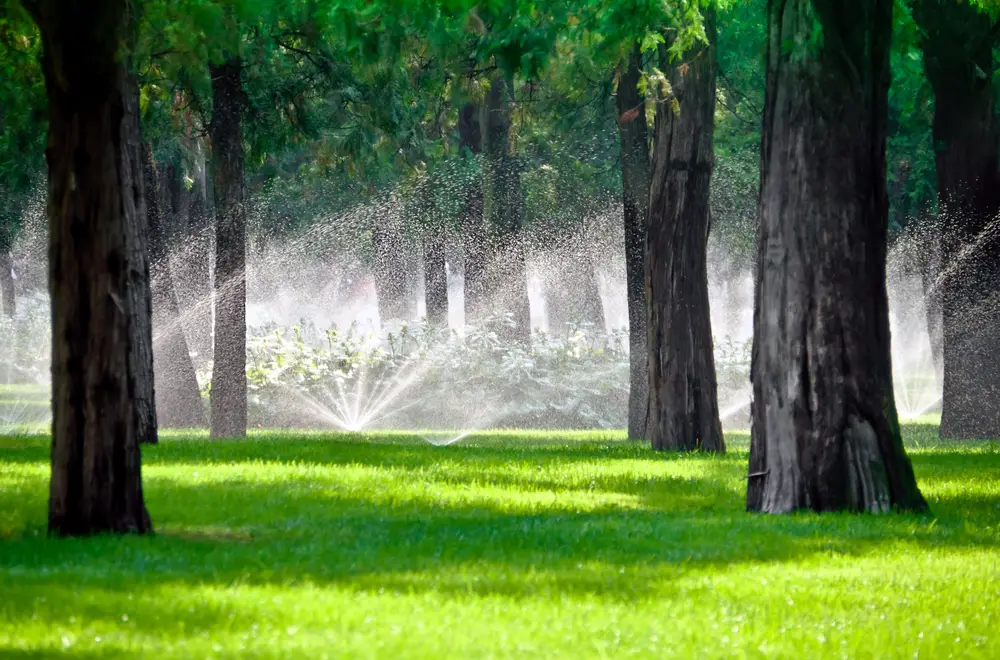Sprinklers are efficient for watering plants.
When looking for options to water your trees, this is the first thing that rings in your head. But wait a moment.
Sometimes, something other than what works best for your lawns may be suitable for your trees.
So, Is It Bad for Sprinkler Water to Hit Trees?
Yes. Sprinklers can be a detriment to your trees because the direct water onto the stems puts them at risk of fungal infection and other dangers.
Keep reading to find out what exactly happens when you use sprinklers to water your trees and how you should do it to minimize damage.
We also have a definitive guide to alternative methods and what you can do to better the health of your trees.
See Also: Can The Sprinklers Run Overnight And Unattended?
Five Negative Effects Of Sprinkler Water On Trees
1. Root Rot
You have probably come across trees that dry all of a sudden. If you are keen to discover why you may realize that death began from the roots.
Sprinklers usually release a lot of water. They make the soil pretty well, which jeopardizes the trees’ roots.
Excess water causes the roots to rot. Fungi thrive in moist conditions and cause the rotting of tree roots.
Root rot leads to the eventual death of the trees because it kills their ability to absorb water and nutrients.
2. Poor Growth
Excess water in the soil causes nutrient imbalance, which affects the trees’ ability to grow and blossom.
Sprinkler water comes out with a lot of force.
Frequent use causes leaching of the soil nutrients, which significantly retards the growth of trees.
3. Bark Peeling Off
Sprinkler water hits the tree barks with so much force that it may eventually force their barks to peel off.
Once the barks break down, a cascade of events follows.
See Also: How Do You Know When It’s Time To Cut Down A Tree?
First, the trees become exposed to disease and insect infestation.
Pests and pathogens will eventually affect the growth of trees or even destroy them completely.
4. Soil Compaction
Sprinkler water also causes soil compaction.
Soil is considered compact when compressed, and the air spaces between the particles reduce.
When soil becomes compacted, oxygen is driven out of it.
This is not good for trees.
5. Sprinkler Water Attracts Pests And Diseases
As we mentioned, sprinklers usually release way too much water.
This excessive release creates moist conditions under which certain pests and diseases thrive.
If they attract the bark, leaves, or roots of the trees, they stand no chance and can be destroyed.
See Also: How Often Should You Run Your Sprinklers?
How To Use Sprinklers To Avoid Damaging Trees
The problems sprinklers pose on trees do not mean you should stop using them.
You can use them in many ways to minimize the adverse effects of sprinklers on trees. Here are four ways you can use sprinklers to reduce damage to trees:
1. Adjust Sprinkler Height
You can adjust the height of your sprinklers such that water will not hit the branches and the stems.
This way, you will save your trees from sprinkler water damage.
No water will damage the barks; therefore, no pathogens or pests will affect them.
2. Avoid Overwatering
The best way to minimize the compactness of the soil and water-logging is to avoid over-watering with sprinklers.
Sprinklers can flood your tree roots and expose them to fungal infection.
You can prevent this by setting an effective sprinkler schedule. You may choose to water your tree twice or thrice a week.
Your schedule will depend on several factors, including the zone’s climate and soil type.
See Also: Can Sprinkler Lines Run Under Concrete?
3. Time Your Watering
Only water your trees at certainties in the day.
Do not water them during a hot afternoon; it impacts the tree barks and leaves significantly.
It is recommended to sprinkle water on trees early in the morning.
At these hours, temperatures are cool enough, allowing your trees to absorb water before the day’s heat sets in.
4. Direct The Sprinkler Water Flow
Position your sprinklers such that water flows away from the tree trunks.
The best way to do this is to reduce the height of the sprinklers to reduce the diameter of the sprinkler covers.
This way, you will avoid pooling a lot of water around the base of your trees.
Apart from preventing root damage, this trick will immensely promote healthy drainage and, indeed, healthy growth of your trees.
Three Alternatives To Sprinklers
Sometimes, it is necessary to apply alternative watering systems. Here are three options to explore:
1. Drip Irrigation
If you are looking for a convenient way to deliver water directly to the roots of your trees, drip irrigation is suitable.
In this method, all you need is a network of horses and emitters to deliver water to the roots of your trees.
With well-established drip irrigation, soil compactness, and overwatering have become a thing of the past.
2. Hand Watering
Hand-watering is the simplest method you can employ to deliver water directly to the roots of your trees.
With this method, no water hits your trees’ trunks, leaves, and branches because you will gently do it yourself.
3. Rain Barrels
Using rain barrels is another efficient and eco-friendly alternative to sprinkler systems.
All you have to set them properly, and they will collect water and direct it to the tree roots.
Besides reducing the amount of water, you need to water your trees; it poses zero damage to them: no over-watering and no pressure on the tree trunks and leaves.
Final words
Sprinklers jet out water with a lot of force that can harm trees if not directed directly into the roots. They can break the tree barks and leaves and cause root rot.
You should familiarize yourself with best practices for using sprinkler water to reduce these effects and the alternative methods we mentioned.

